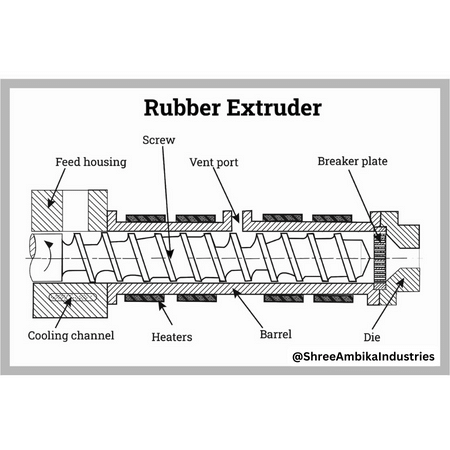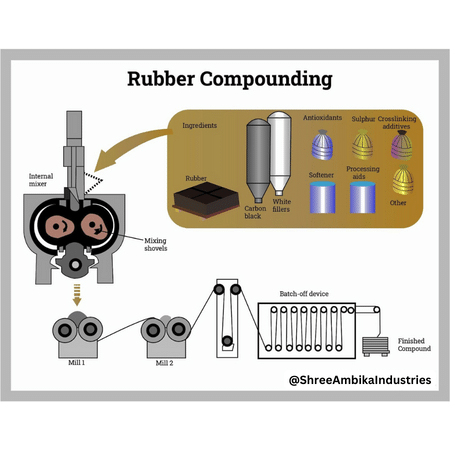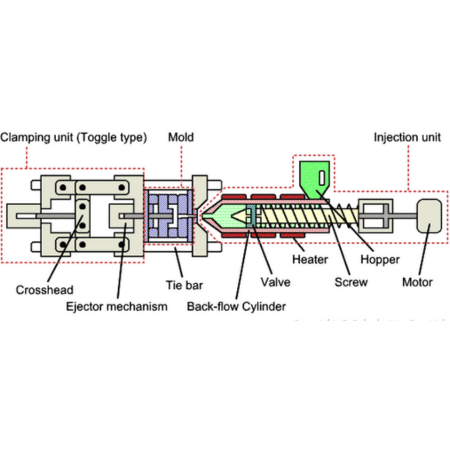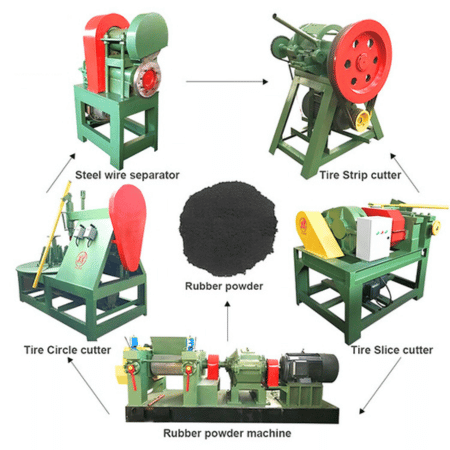The rubber manufacturing industry has come a long way since its inception, with the advent of cutting-edge technologies revolutionizing every aspect of production. These technologies have not only improved the quality and efficiency of rubber products but have also made the industry more environmentally friendly. In this article, we’ll delve into the top technologies that rubber manufacturing companies are using to enhance their processes, reduce waste, and meet the ever-increasing demand for high-quality rubber products.
Let’s dive deeper into each of the key technologies used in rubber manufacturing companies, exploring their intricacies, applications, and the impact they have on the industry.
Extrusion Technology
Extrusion is a fundamental process in rubber manufacturing, playing a vital role in shaping raw rubber materials into various products. This process involves forcing the rubber compound through a die to create profiles such as hoses, gaskets, seals, and more. Over the years, advancements in extrusion technology have transformed the industry by enhancing precision, consistency, and overall efficiency.

- Cold Feed Extrusion: This method involves feeding un-vulcanized rubber compounds through a cooled extruder. Cold feed extrusion is highly beneficial when dealing with heat-sensitive materials that can degrade at high temperatures. It allows for precise control over the extrusion process, resulting in products with accurate dimensions and properties.
- Hot Feed Extrusion: In contrast, hot feed extrusion involves pre-heating the rubber compound before it enters the extruder. This method is ideal for materials that require higher processing temperatures. Hot feed extrusion provides better flow properties and ensures effective vulcanization.
Computer-Controlled Extrusion: One of the most significant advancements in extrusion technology is the integration of computer control systems. These systems allow for real-time monitoring and adjustment of critical parameters, such as temperature, pressure, and feed rates. This level of control ensures product consistency and minimizes material wastage.
Applications: Extrusion technology is widely employed in the production of various rubber products, including automotive weatherstripping, window seals, and tubing for medical devices. In the automotive industry, precision extrusion ensures that seals and gaskets fit perfectly, contributing to vehicle efficiency and safety.
Rubber Compounding
Rubber compounding is the art and science of mixing various ingredients to create specific rubber formulations. This process is crucial for achieving desired material properties and performance characteristics. Modern rubber manufacturers use computerized systems to precisely measure and mix ingredients, ensuring consistent product quality and improved efficiency.

- Ingredient Selection and Mixing: Rubber compounds typically consist of rubber polymers, fillers, vulcanizing agents, and various additives. The choice of ingredients and their proportions are critical in achieving specific properties such as hardness, resilience, and chemical resistance. Advanced compounding systems allow for the precise measurement and mixing of these components.
- Automated Compounding Systems: Automated compounding systems have significantly reduced the margin for human error in the rubber compounding process. These systems provide accurate batch sizes, improving material consistency and minimizing waste. The automated process ensures that the rubber compound’s composition remains within tight tolerances, meeting product specifications.
Applications: Rubber compounding is essential in the production of a wide range of rubber products, including tires, hoses, belts, and industrial components. Precise control over the compounding process results in consistent product quality, which is critical in applications like automotive tires, where performance and safety are paramount.
Vulcanization
Vulcanization is a fundamental process in rubber manufacturing, transforming raw rubber into a durable, resilient material by chemically cross-linking polymer chains. This process involves heating the rubber compound with sulfur and other additives. Vulcanization technology has evolved significantly over time, resulting in more efficient and precise processes.

- Computer-Controlled Vulcanization Systems: In the early days of rubber manufacturing, vulcanization was a relatively manual and labor-intensive process. Modern rubber manufacturing companies have shifted to computer-controlled vulcanization systems. These systems allow for precise control over temperature and time, resulting in consistent vulcanization and reduced energy consumption.
- Continuous Vulcanization Processes: Traditional vulcanization methods involved batch processes, which could be time-consuming and less energy-efficient. Continuous vulcanization processes, such as microwave vulcanization and hot air vulcanization, offer faster and more energy-efficient vulcanization of rubber compounds. These methods are especially valuable in industries with high production volumes.
Applications: Vulcanization is essential in the production of various rubber products, including tires, conveyor belts, shoe soles, and industrial seals. The ability to control vulcanization parameters precisely ensures that these products meet stringent quality standards and performance requirements.
Injection Molding
Injection molding is a widely used technique in the rubber manufacturing industry for producing a variety of products, from automotive components to medical devices. Advancements in injection molding technology have enhanced precision, reduced cycle times, and minimized material wastage.

- Servo-Driven Injection Molding Machines: Traditional hydraulic injection molding machines have given way to more efficient servo-driven machines. These machines offer greater control over the injection and clamping processes, resulting in higher precision and repeatability. This not only reduces material wastage but also contributes to the overall efficiency of the manufacturing process.
- Automation and Robotics: Automation and robotics are increasingly integrated into the injection molding process. Automated systems handle material feeding, part removal, and quality inspection. Robotics further enhance production efficiency, reduce labor costs, and minimize the risk of errors.
Applications: Injection molding is used in the production of a wide array of rubber products, including automotive seals, electrical connectors, and medical device components. The precision and consistency offered by modern injection molding technology are particularly valuable in applications where tight tolerances and high-quality standards are essential.
Eco-Friendly Initiatives
In recent years, there has been a growing emphasis on eco-friendly manufacturing practices within the rubber industry. Many companies are adopting sustainable practices and technologies to reduce their environmental footprint.

- Recycling and Reuse: Recycling of rubber materials and reusing them in the manufacturing process has gained prominence. Old tires, for example, can be ground into rubber crumb and used in the production of new rubber products. This not only reduces waste but also conserves valuable resources.
- Energy Optimization: Rubber manufacturing companies are increasingly investing in energy-efficient technologies. From modern vulcanization processes to energy-efficient machinery, these initiatives aim to reduce the environmental impact of production while also cutting operational costs.
- Eco-Friendly Rubber Compounds: The development of eco-friendly rubber compounds is another noteworthy trend. These compounds often incorporate recycled materials or utilize biodegradable components, reducing the overall environmental impact of rubber products.
Applications: Eco-friendly initiatives in rubber manufacturing are not only good for the environment but also appeal to consumers who are increasingly conscious of sustainability. These practices are particularly relevant in industries where eco-friendly materials are prioritized, such as in construction, automotive, and consumer goods.
Quality Control and Testing
Quality control and testing are crucial aspects of rubber manufacturing, ensuring that products meet stringent standards and specifications. Advanced technologies for non-destructive testing have revolutionized the way defects are detected and product integrity is maintained.

- Ultrasonic and X-ray Inspection: Ultrasonic and X-ray inspection techniques have become essential for quality control in rubber manufacturing. Ultrasonic testing involves the use of high-frequency sound waves to detect internal defects, while X-ray inspection allows for the inspection of complex components. These methods help ensure that products are free from hidden flaws.
- Automated Quality Control: Automated quality control systems incorporate sensors and cameras to inspect rubber products during and after the manufacturing process. These systems identify defects and variations, allowing for real-time adjustments to maintain product quality.
Applications: Quality control and testing are vital in industries where the performance and safety of rubber products are critical. For example, in the aerospace and medical device sectors, where even small defects can have serious consequences, these technologies help ensure product integrity and reliability.
In conclusion, the rubber manufacturing industry has been transformed by a range of cutting-edge technologies. From the early stages of material compounding and mixing to the final steps of product inspection and packaging, these technologies enhance efficiency, reduce waste, and ensure consistent product quality. Moreover, the industry is increasingly embracing eco-friendly initiatives to minimize its environmental footprint. As the rubber manufacturing sector continues to evolve, we can expect even more innovative technologies and practices that will drive further improvements in product quality, sustainability, and efficiency. These advancements will benefit not only manufacturers but also consumers who rely on rubber products in their daily lives.